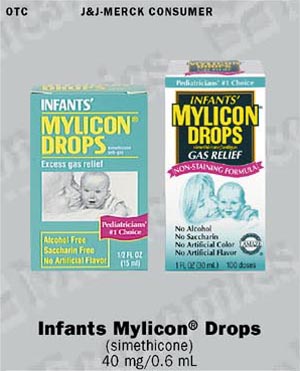
Each 0.6 mL of drops contains: Active: simethicone, 40 mg. Inactive: carboxymethylcellulose sodium, citric acid, manitol microcrystalline cellulose, natural flavor, purified water, Red 22, Red 28, sodium benzoate, sodium citrate, xanthan gum, non-staining formula contains no Red 22 or Red 20.
For relief of the symptoms of excess gas in the digestive tract. Such gas is frequently caused by excessive swallowing of air or by eating foods that disagree. The defoaming action of INFANTS' MYLICON® Drops relieves flatulence by dispersing and preventing the formation of mucus-surrounded gas pockets in the gastrointestinal tract. INFANTS' MYLICON® Drops act in the stomach and intestines to change the surface tension of gas bubbles enabling them to coalesce, thereby freeing and eliminating the gas more easily by belching or passing flatus.
Infants (under 2 years): 0.3 ml four times daily after meals and at bedtime, or as directed by a physician. The dosage can also be mixed with 1 oz of cool water, infant formula or other suitable liquids to ease administration.
Adults and children: 0.6 ml four times daily, after meals and at bedtime, or as directed by a physician.
Do not exceed 12 doses per day except under the advice and supervision of a physician. Keep this and all drugs out of the reach of children.
INFANTS' MYLICON® Drops are available in bottles of 15 ml (0.5 fl oz) and 30 ml (1.0 fl oz) original pink, pleasant tasting liquid and non-staining formula. NDC 16837-630; 16837-911.
 |